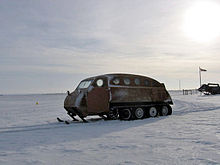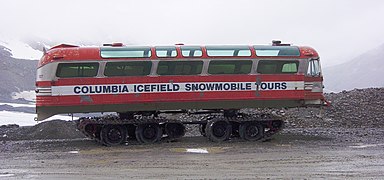Transport in Antarctica has transformed from explorers crossing the isolated remote area of Antarctica by foot to a more open era due to human technologies enabling more convenient and faster transport, predominantly by air and water, but also by land as well. Transportation technologies on a remote area like Antarctica need to be able to deal with extremely low temperatures and continuous winds to ensure the travelers' safety. Due to the fragility of the Antarctic environment, only a limited amount of transport movements can take place and sustainable transportation technologies have to be used to reduce the ecological footprint. The infrastructure of land, water and air transport needs to be safe and sustainable. Currently thousands of tourists and hundreds of scientists a year depend on the Antarctic transportation system.
Bombardier Inc. is a Canadian business jet manufacturer. Headquartered in Montreal, the company was founded in 1942 by Joseph-Armand Bombardier to market his snowmobiles and became one of the world's biggest producers of aircraft and trains.

Jasper National Park, in Alberta, Canada, is the largest national park within Alberta's Rocky Mountains, spanning 11,000 km2 (4,200 sq mi). It was established as Jasper Forest Park in 1907, renamed as a national park in 1930, and declared a UNESCO world heritage site in 1984. Its location is north of Banff National Park and west of Edmonton. The park contains the glaciers of the Columbia Icefield, springs, lakes, waterfalls and mountains.

A snowmobile, also known as a snowmachine, motor sled, motor sledge, skimobile, or snow scooter, is a motorized vehicle designed for winter travel and recreation on snow.

Joseph-Armand Bombardier was a Canadian inventor and businessman who was the founder of Bombardier. His most famous invention was a snowmobile.

BRP Inc. is a Canadian manufacturer of snowmobiles, all-terrain vehicles, side by sides, motorcycles, and personal watercraft. It was founded in 2003, when the Recreational Products Division of Bombardier Inc. was spun off and sold to a group of investors consisting of Bain Capital, the Bombardier-Beaudoin family and the Caisse de dépôt et placement du Québec. Bombardier Inc., was founded in 1942 as L'Auto-Neige Bombardier Limitée by Joseph-Armand Bombardier at Valcourt in the Eastern Townships, Quebec.

An off-road vehicle (ORV), sometimes referred to as an off-highway vehicle (OHV), overland vehicle, or adventure vehicle, is considered to be any type of vehicle that is capable of driving off paved or gravel surfaces, such as trails and forest roads that have rough and low traction surfaces.

The Columbia Icefield is the largest ice field in North America's Rocky Mountains. Located within the Canadian Rocky Mountains astride the Continental Divide along the border of British Columbia and Alberta, Canada, the ice field lies partly in the northwestern tip of Banff National Park and partly in the southern end of Jasper National Park. It is about 325 square kilometres (125 sq mi) in area, 100 to 365 metres in depth and receives up to 7 metres (280 in) of snowfall per year.

The Tucker Sno-Cat is a family of tracked vehicles for snow conditions, manufactured in Medford, Oregon by the company of the same name.
Thiokol and Northrop Grumman was an American corporation concerned initially with rubber and related chemicals, and later with rocket and missile propulsion systems. Its name is a portmanteau of the Greek words for sulfur and glue, an allusion to the company's initial product, Thiokol polymer.
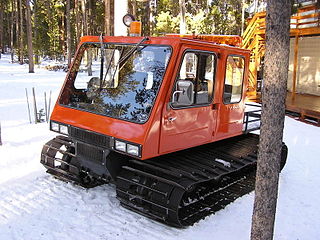
A snowcat is an enclosed-cab, truck-sized, fully tracked vehicle designed to travel over snow. Major manufacturers are PistenBully (Germany), Prinoth (Italy), and Tucker.
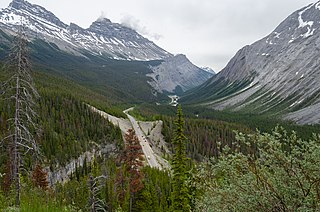
Highway 93 is a north–south highway in Alberta, Canada. It is also known as the Banff-Windermere Parkway south of the Trans-Canada Highway (Highway 1) and the Icefields Parkway north of the Trans-Canada Highway. It travels through Banff National Park and Jasper National Park and is maintained by Parks Canada for its entire length. It runs from the British Columbia border at Vermilion Pass in the south, where it becomes British Columbia Highway 93, to its terminus at the junction with the Yellowhead Highway (Highway 16) at Jasper. The route takes its number from U.S. Route 93, which runs uninterrupted south to central Arizona, and was initially designated as '93' in 1959.

Snow grooming is the process of manipulating snow for recreational uses with a tractor, snowmobile, piste caterpillar, truck or snowcat towing specialized equipment. The process is used to maintain ski hills, cross-country ski trails and snowmobile trails by grooming the snow on them. A variation of the technique is used to construct snow runways in Antarctica.

The Athabasca Glacier is one of the six principal 'toes' of the Columbia Icefield, located in the Canadian Rockies. The glacier currently loses depth at a rate of about 5 metres (16 ft) per year and has receded more than 1.5 km (0.93 mi) and lost over half of its volume in the past 125 years. Easily accessible, it is the most visited glacier in North America. The leading edge of the glacier is within easy walking distance; however, travel onto the glacier is not recommended unless properly equipped. Hidden crevasses have led to the deaths of unprepared tourists.
The following outline is provided as an overview of and topical guide to transport:

The Aktiv Grizzly was a dual-track snowmobile made by Aktiv Maskin Östersund AB in Sweden from 1979 to 1991. The Grizzly is still recognized as one of the best dual-track snowmobiles in the world. The snowmobile's tracks covered almost one square meter, making it well suited for use in deep snow. Similar dual-track snowmobiles include Bombardiers Ski-Doo Alpine, Ski-Doo Alpine 2 and Ockelbo 8000. Currently two dual-track snowmobile are in production, one in Russia under the name "Buran" and one in Italy, "Alpina Sherpa".

The Snow Trac is a small personal Snowcat that is roughly the size of a modern compact car. Aktiv Snow Trac were manufactured in Sweden between 1957 and 1981, with additional vehicles manufactured in Scotland.
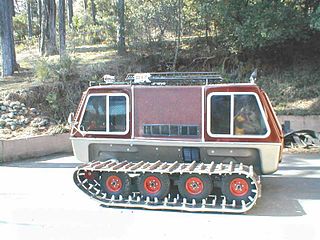
Kristi snowcats were 1950s/1960s tracked vehicles suitable for snow and other terrain and produced originally in Colorado and then later in Washington.

Logan Manufacturing Company was a US manufacturer of snowcats that ceased operation in 2000. LMC is both the tradename and an acronym.

Neumayer Station III, also known as Neumayer III after geophysicist Georg von Neumayer, is a German Antarctic research station of the Alfred-Wegener-Institut. It is located on the approximately 200 metres (660 ft) thick Ekström Ice Shelf several kilometres south of Neumayer Station II. The station's assembly kit was transported to its current position early in November 2007. It is moving with the shelf ice at about 157 meters (515 ft) per year towards the open sea.

